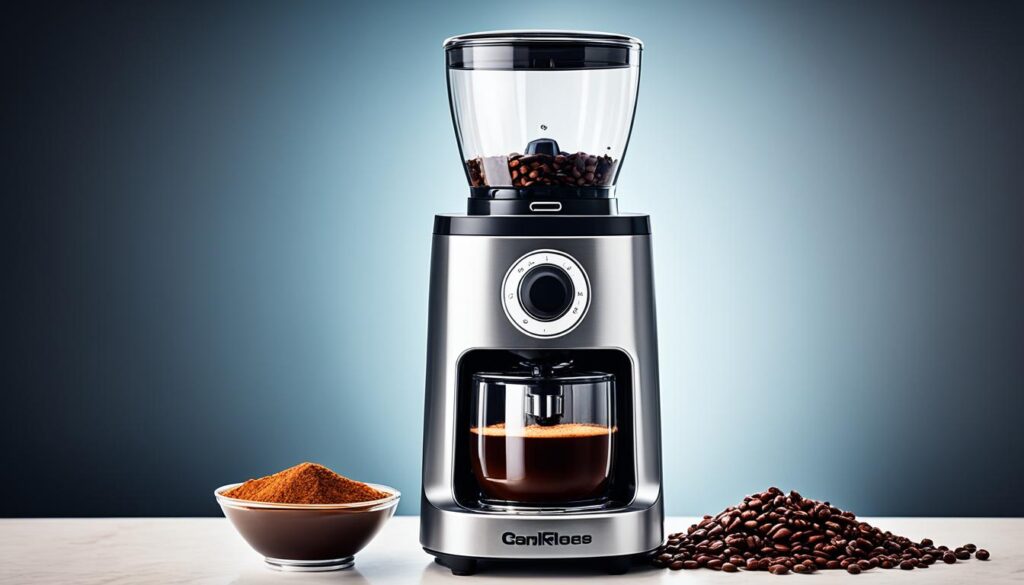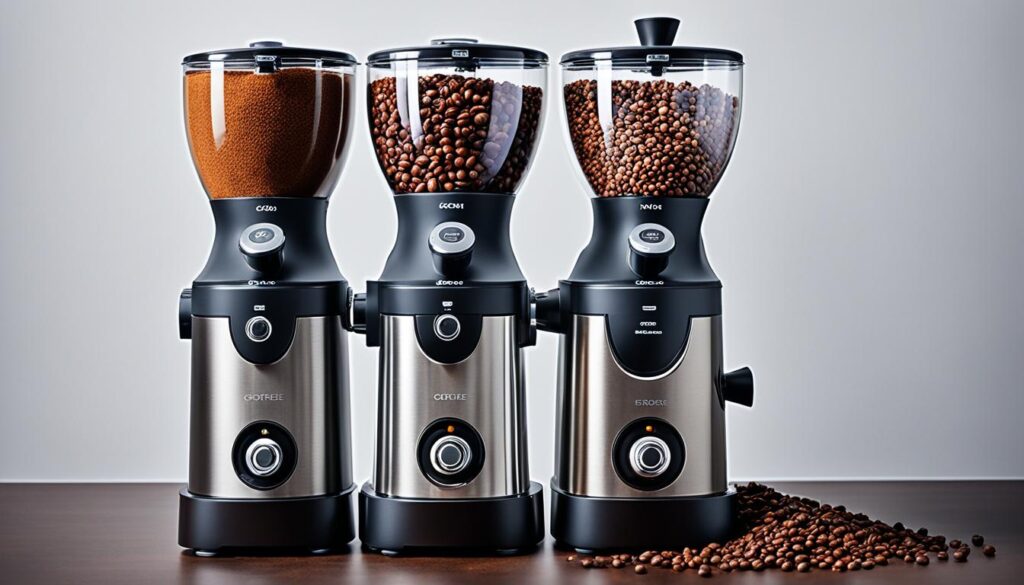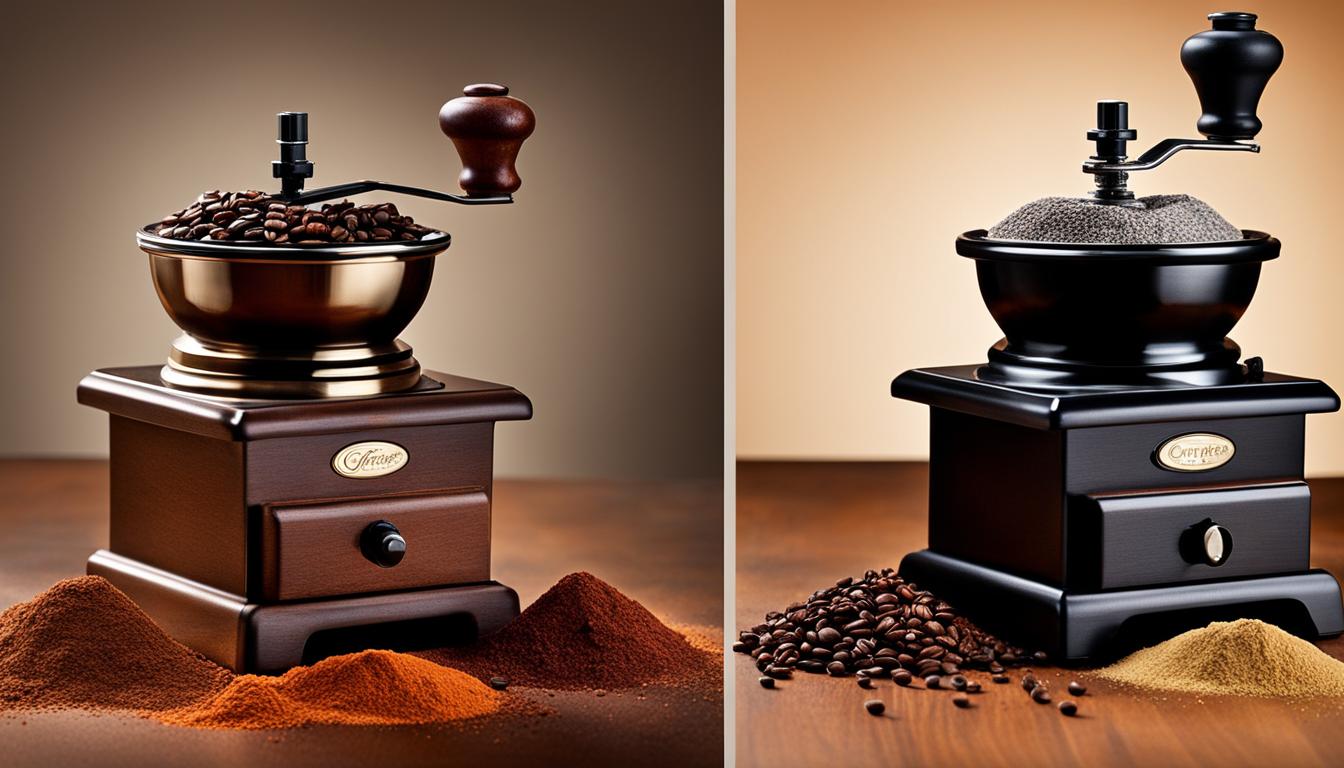Are you someone who loves a freshly brewed cup of coffee as much as the rich aroma of freshly ground spices? If so, you must have wondered about the differences between coffee grinders and spice grinders. Do they serve the same purpose? Can you use one for the other? Let’s dive in and uncover the key differences between these two essential kitchen tools.
When it comes to coffee grinders, they are specifically designed for grinding coffee beans to achieve the perfect grind size for your brewing method. On the other hand, spice grinders offer versatility and can handle a variety of spices, making them indispensable for enhancing the flavors in your culinary creations.
But what about the construction and functionality of these grinders? How do they achieve the desired grind consistency? And which type of grinder offers greater convenience and control? Read on to find out!
Blades vs Burrs: Grinding Mechanism Differences
When it comes to grinding mechanisms, coffee grinders and spice grinders differ significantly. Coffee grinders typically use burrs, while spice grinders rely on spinning blades. Let’s explore the differences between these two mechanisms and how they impact the grind consistency.
Coffee Grinder Mechanism: Burrs
Coffee grinders use burrs to crush coffee beans uniformly and achieve a consistent grind size. Burrs consist of two abrasive surfaces, often made of ceramic or stainless steel, that grind the beans between them. This process ensures that each particle is evenly ground, allowing for optimal flavor extraction and a consistent taste in every cup of coffee. The ability to achieve a uniform grind size is particularly important for brewing methods like espresso, where precision is key.
Spice Grinder Mechanism: Blades
On the other hand, spice grinders utilize spinning blades to chop and slice spices. These blades, often made of stainless steel, rotate at high speeds, pulverizing the spices into smaller particles. However, due to the slicing action of the blades, the resulting grind size is typically less consistent compared to coffee grinders. While this may not be as critical for spice grinding, where texture and flavor are still achieved, it may affect the overall consistency of dishes that require finely ground spices.
Below is a summary table highlighting the main differences in grinding mechanisms:
| Grinding Mechanism | Grind Consistency | Applications |
|---|---|---|
| Burrs (Coffee Grinders) | Uniform and consistent | Ideal for coffee brewing |
| Blades (Spice Grinders) | Less consistent | Suitable for general spice grinding |
As demonstrated in the table, coffee grinders with burrs provide a more uniform and consistent grind size, making them especially suitable for coffee brewing. However, spice grinders with spinning blades are still effective for most spice grinding needs, despite producing a less consistent grind.
Now that we understand the differences between blades and burrs, let’s explore the convenience and control factors of electric and manual grinders in the next section.
Electric vs Manual: Convenience and Control
When it comes to choosing between an electric coffee grinder and a manual spice grinder, there are a few key factors to consider: convenience and control. Both options have their own advantages and appeal to different types of users.
Electric Coffee Grinder: Quick and Easy Convenience
For those seeking convenience and a faster grinding process, an electric coffee grinder is the way to go. With just a push of a button, you can effortlessly grind your coffee beans to the desired consistency. This is particularly advantageous for users who need their daily dose of caffeine without spending too much time and effort on preparation. Electric coffee grinders offer a streamlined experience, allowing you to grind your coffee beans in seconds, making them ideal for busy mornings or when you’re in a rush.

Manual Spice Grinder: Precision Control for Grind Size
Manual spice grinders, on the other hand, require a bit more physical effort but offer a unique level of control over the grinding process. With a manual grinder, you have the power to determine the exact grind size, allowing for precision in achieving your desired consistency. This level of control is particularly valued by coffee aficionados and spice enthusiasts who understand the importance of grind size in extracting the flavors they desire. Manual spice grinders give you the freedom to experiment and tailor your grind size to match your specific needs, resulting in a more personalized and satisfying culinary experience.
Choosing What Works Best for You
Ultimately, the choice between an electric coffee grinder and a manual spice grinder boils down to your personal preferences and specific requirements. If convenience and speed are top priorities, an electric coffee grinder will suit your needs perfectly. On the other hand, if you value control and precision in achieving the perfect grind size, a manual spice grinder will provide the level of customization you seek. By understanding your priorities and preferences, you can make an informed decision that enhances your coffee brewing or spice grinding experience.
“Electric coffee grinders offer convenience and speed, while manual spice grinders provide precision control over grind size.”
| Electric Coffee Grinder | Manual Spice Grinder |
|---|---|
| Convenience with the push of a button | Requires physical effort |
| Faster grinding process | More time-consuming |
| Less control over grind size | Precision control over grind size |
Pros and Cons: Coffee Grinder vs Spice Grinder
When it comes to choosing between a coffee grinder and a spice grinder, it’s important to consider the pros and cons of each option. Both types of grinders have their own unique advantages and limitations, so let’s take a closer look at what they have to offer.
Pros of Coffee Grinders
- Consistent grind size: Coffee grinders, particularly those with burr mechanisms, are designed to provide a consistent grind size. This is crucial for achieving optimal flavor and extraction in coffee, as it ensures that all the particles are exposed to the same level of heat or water during the brewing process.
- Versatility: Coffee grinders offer a wide range of grind size options, making them versatile for different brewing methods. From coarse grinds for French press to fine grinds for espresso, you can easily adjust the grind size to suit your preferred brewing style.
Cons of Coffee Grinders
- Higher cost: Coffee grinders, especially those with burr mechanisms, tend to be more expensive compared to spice grinders. The precision engineering and construction required for achieving a consistent grind size can contribute to the higher price tag.
- Not suitable for spices: While coffee grinders excel at grinding coffee beans, they are not designed for grinding spices. The burr mechanism and grind settings of coffee grinders are optimized for coffee beans, and using them for grinding spices may result in flavor contamination and damage to the grinder.
Pros of Spice Grinders
- Affordability: Spice grinders are generally more affordable compared to coffee grinders. They offer a budget-friendly option for those who primarily intend to grind spices.
- Versatility: Spice grinders are versatile and can handle a variety of dried spices. Whether it’s grinding whole spices like cinnamon and cloves or creating custom spice blends, a spice grinder can be a valuable addition to your kitchen arsenal.
Cons of Spice Grinders
- Grind consistency: Spice grinders, particularly those with spinning blades, may not offer the same level of grind consistency as coffee grinders with burr mechanisms. The resulting grind size may vary, which can impact the flavor and texture of the spices in your recipes.
While coffee grinders and spice grinders offer their own set of pros and cons, the key is to choose the grinder that best suits your specific needs. If you’re a coffee enthusiast looking for precision and a consistent grind size, investing in a coffee grinder with burr mechanisms is worth considering. On the other hand, if you primarily need a grinder for grinding spices and want a more affordable option, a spice grinder will serve you well. Ultimately, having both a coffee grinder and a spice grinder in your kitchen can provide the versatility you need to enhance your culinary creations.

Importance of Grind Consistency in Coffee and Spices
Grind consistency plays a vital role in achieving the best flavor extraction, whether you’re brewing coffee or grinding spices. When the grind is uniform, all the particles are exposed to the same level of heat or water during the extraction process, resulting in a more balanced and rich flavor profile.
If you’re looking to elevate your coffee brewing or spice grinding experience, achieving a consistent grind is key. It ensures that every sip or bite is bursting with the intended flavors and aromas.
Different brewing methods require specific levels of grind consistency to achieve optimal results. For longer extraction methods like French press or cold brew, coarser grinds are preferred. The larger particles allow for a slower extraction and a bolder flavor. On the other hand, quicker methods such as espresso or AeroPress demand finer grinds. The smaller particles enable faster extraction and deliver a more intense flavor profile.
The Recommended Grind Sizes for Different Brewing Methods:
| Brewing Method | Grind Size |
|---|---|
| French Press | Coarse |
| Coffee Drip | Medium |
| Espresso | Fine |
| Cold Brew | Coarse |
| AeroPress | Medium-Fine |
By understanding the appropriate grind size options for different brewing methods, you can tailor your grinding technique to achieve the desired taste and quality in your coffee or spices.
For coffee enthusiasts and culinary explorers alike, consistency in grind size is the key to unlocking the full potential of flavors. It ensures that every cup of coffee or every dish you prepare is a true delight for your senses.
Conclusion
In conclusion, when comparing coffee grinders and spice grinders, it is clear that they have key differences that make them suitable for different purposes in the kitchen. Coffee grinders, with their burr grinding mechanism, are designed specifically for grinding coffee beans and offer a consistent grind size for optimal flavor extraction in coffee brewing. On the other hand, spice grinders use spinning blades and are versatile in grinding a variety of spices, making them a great addition to any spice lover’s kitchen.
Understanding these key differences is crucial in choosing the right grinder for your specific needs. If you are a coffee enthusiast who values a consistent grind for your favorite brewing method, investing in a coffee grinder with burrs is a wise choice. However, if you enjoy experimenting with different spices and need a grinder that can handle a variety of grinding tasks, a spice grinder with spinning blades may be more suitable for you.
Ultimately, having both a coffee grinder and a spice grinder in your kitchen can enhance your culinary experiences. With the right grinder for each purpose, you can ensure that your coffee and spices are ground to perfection, resulting in the best flavors and aromas in your favorite recipes and beverages.
